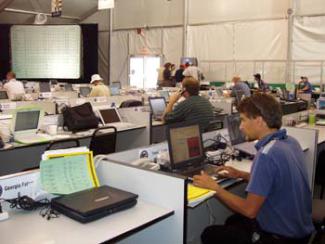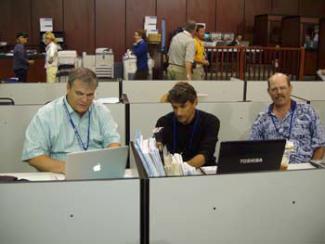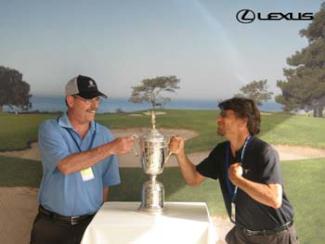Featured Golf News
Cybergolf Contributor Discusses 10th Anniversary as Golf Writer

Jay at his First U.S. Open in 2005
Jay Flemma has been a contributor to Cybergolf since 2006. I threw him right into the fire that year by making Jay's initial assignment the U.S. Open at Winged Foot.
During his eight-year stint at Cybergolf, Jay has won four Golf Writers Association of America awards, joining our own Marino Parascenzo and Tony Dear in earning national recognition among his peers. Jay is a commentator on GNN Radio and currently has several other irons in the fire.
He's celebrated his 10th anniversary as a golf writer this week. The New York City-based attorney posted his first story on his blog, "A Walk in the Park," on November 19, 2004.
Here's my Q&A with Jay. As you'll see he's one of golf's most pugnacious and incisive writers working today.
1. What made you want to become a golf writer?
It was more dumb luck than anything. I never planned this or even dreamed about it; it just happened organically. I was tired of paying $200 for overrated, uninteresting courses, and I was especially tired of six-and-a-half-hour rounds on crappy NYC munis.
Well, one day in late 2004 as I'm waiting to hit to the green at the eighth hole at Forest Park this kid runs onto the green, grabs the flagstick, and starts dancing around like a majorette. We all yell at him to get off the green, which he does . . . by jumping over the fence, hopping into a waiting van, and taking off down the road with the flag. I said, "That's it! I'm going to write a book about where to play and where not to play!"
So, shortly thereafter, I tell that story to a client of mine - these five funny but socially awkward kids from an Ivy League school that formed a comedy troupe. The obnoxiously haughty and judgmental one says to me, "Oh, so you think you can write?"
That pissed me off. I've always been a writer. I wrote long essays even in grammar school, and when you go to Deerfield Academy and Trinity College in Connecticut you write every single weekend. I've lived by Strunk & White's style guide since I was 13.
"Yes,'" I snarled laconically. "I certainly can." I also thought to myself, "I'll be damned if Hippie Hipster here is gonna look down his nose at me when it comes to writing."
"Well why don't you start a blog then?" he asked.
That stopped me in my tracks. "That's a great idea!" I thought: Free website, practice writing and I get to meet people.
So I did start a blog, and four months later I got hired by two different well-established magazines and was credentialed to go to the 2005 U.S. Open at Pinehurst. It was like a scene out of "That Thing You Do" how fast it happened, and there were definitely "pinch-me" moments.
I remember walking in and being astounded at the sheer size of the media tent; there were 425 desks and 39 radio booths I think. When I went to my seat - WOW! - I was between Melanie Hauser on my left and Marino Parascenzo on my right, the GWAA treasurer and a PGA of America Lifetime Achievement Award winner. Right in front of me were Tim Rosaforte of Golf Channel and Jaime Diaz, and behind me was Sal Johnson of Golf Observer.
You better write well, I said to myself.
So I have to add, I suppose, I should be thanking Hippie Hipster because if he hadn't have given me the blog idea I might not be talking to you here 10 years later.
2. What was your first published golf article and where did it appear?

The first pieces I ever wrote were golf reviews for my website, "A Walk in the Park" - http://jayflemma.thegolfspace.com - and some smaller online 'zines. But my first real article for a recognized publication with an A-list masthead was a bio of Old Tom Morris for Golf Observer to be published Sunday morning of the 2005 Open Championship.

Jay & Marino Parascenzo Make a
Great 1-2 Combo at Majors
Talk about scary . . . at that time, I knew only superficial things about St. Andrews, I knew nothing about Old Tom Morris, and I was as green as peas in terms of developing my voice as a writer. I was petrified.
I said to myself Saturday afternoon, when I had nothing of any use to say and mere hours to go before my first deadline, "All those great names on that masthead, this wonderful magazine, and this editor - this 'made' guy who's been everywhere and done everything, who drank with guys like Roone Arledge and Howard Cosell - taking a flyer on me, my big chance with everyone watching . . . and I'm going to bomb!"
But I muddled through with the gracious help of the good folks at St. Andrews and some marvelous, astoundingly cool photos Sal Johnson found, and by sticking mostly to golf architecture and history - my strong suits - it came out well, well enough that my audience liked it.
3. How did you get connected with Cybergolf?
It was maybe about six months later. I had been corresponding with one of your original writers, and he suggested I reach out to Jeff Shelley, and I did.
Winged Foot was my first Cybergolf gig, and that's when the light bulb went on. I got in the tent, now I had to show I was worthy. You better write well, I said to myself again.
I worked hard that week, and my hustle paid off with some humor. My favorite happy memory of that tournament was making [name of prominent journo redacted] and [name of quintessential broadcaster redacted] crack up laughing while I was interviewing Fred Couples. I was in the clubhouse on Wednesday getting all my prep work done, so I lassoed Freddie for some talk on Xs and Os . . . only problem is, that's not Freddie's forte. I hear the journo say to the broadcaster, "Oh, this oughta be good. He's gonna try and interview Freddie."
So I start asking Fred about breaking down the golf course - where to attack it, where to lay back, what's his strategy - you know, garden-variety stuff. Freddie just mumbles, looks blankly, goes "uhhhhhhh" and otherwise just flails, the poor guy. With each passing question the two observers are snickering and covering laughs with coughs, and I'm just getting nothing because Freddie's so confused at this point from having to deep-think. So finally, I just decide to end the pain and ask Freddie a softball.
"What's in your iPod?"
"iPOD?" he asks, pronouncing it completely incorrectly - "eye-PAHD" he said, stressing the second syllable! "I don't HAVE an eye-PAHD."
"How about your CD player?"
"I don't HAVE a CD player."
By now my puckish side/tested-tolerance gets the best of me. "Okay, but you do know there is such a thing as consumable music, and that they sell items called stereos on which you can PLAY consumable music?"
"Yes," he harrumphs.
"What do you have to play your consumable music?"
"An 8-track."
Now the two are cackling like the Blair Witch.
"And what 8-tracks do you have?"
"ROY ORBISON!" he shouts! End of interview.
Laughing, each of the onlookers puts an arm around me and said, "Don't try to pick his brain. He doesn't have a brain to pick! Ask him about the Boom-boom Girls!"
4. What has it been like working with Cybergolf editor Jeff Shelley?
I'll tell you my two favorite Jeff stories. First was the day we applied for Masters creds one year. It was the Monday after Ernie Els flushed that huge lead at the 72nd hole of the Alfred Dunhill Championship in 2007. So I pull up the website and what's the headline blaring back at me? "ELS BLOWS ALFRED DUNHILL." [Editor's Note: This lamented header also made it to the home page of Fark.com.]
Cue the laugh track.
So here's how cool Jeff is - I call him to give him the heads-up, and he starts laughing with me about it uproariously. That's one of the reasons why he's so universally liked - he can laugh at himself - he's so remarkably human. That's refreshing when so many people in our business are selling an image. Jeff's so reliable and trustworthy.
My other favorite Jeff story is the time I got a little blue in an article . . . and by blue I mean not safe for work . . . waaaaaaaaaaaaay not safe! It took me 48 hours to get from NYC to Atlanta for the 2011 PGA, so I went all Hunter S. Thompson on the jackanape airline employees and dingbat waitresses and such that gave me so many migraines I needed a vat of Exedrine. I fired a full broadside at everybody and everything (especially Tiger) and in the process made a joke about a toy . . . yes, that kind of toy.
I left it in there knowing Jeff would take it out. Of course he'd take it out, right? He'd laugh and hit the delete button.
I just had to leave it in the draft that went to him for a combination of journalistic integrity, homage to Thompson, rakishness on my part, and because the joke was stratospherically good and involved my gorgeous girlfriend Britt. (She loved it, by the way. You go, girl!)
What happens? There it is in print! Oh . . . my . . . God.
So I call Jeff, chuckling to myself, and tell him I think he really ought to remove it. "Oh no, it's fine," he says.
Uh . . . no, it's not. At all.
He takes a third look at it and says something like, "Well if you really want it out, okay." So the safe version is up at Cybergolf, the NSFW version on my website. I especially like the part where I get locked out of my hotel room at midnight in my underwear. Here's the PG-13 version: http://www.cybergolf.com/golf_news/fear_loathing_on_the_major_championship_trail_2011_pga_championship_edition.

5. Do you have any golf writer inspirations? If so, who?
First and foremost, Dan Jenkins and Marino Parascenzo. Dan Jenkins is everything you could seek in a role model - humble, hard-working and generous. He stands for Golf, God, and Country, and I feel exactly the same way, add sushi and a beautiful girl as needed. As a writer, Jenkins is a fabulous satirist. And talk about relevant, look at what happened when Tiger Woods recently turned a good Jenkins piece into a great piece by doing the one thing guaranteed to make sure everyone read it!
On our best days, we all wish we were Jenkins.
Marino is also all you could ask for in a mentor and friend. He's an old-school guy and a lifer. He's someone that you call yourself lucky to have as a friend and confidant: great journalist, even better person.
There are gracious gentlemen like John Hopkins - I personally take it as a badge of honor that I've made him laugh at things I wrote. We like people who like us, and when good people like Jenks, Hoppy and Marino like you, you know you're doing something right. But there's so much to learn from so many of the guys - from Hank Gola to Gary Van Sickle, from Ian Baker-Finch to John Garrity, from David Clarke to Kevin Cook. If I had to name everybody who taught me something or who I look up to in the media tent, I'd never finish this interview. (And to anyone I've left out - like Tony Korologos or Marv Beatty - please don't go all Maleficent on me for forgetting you.)
Writer inspirations are just as important to me too, though. Umberto Eco, Ernest Hemingway, Hunter S. Thompson are probably my biggest influences, but so is anyone that writes with a passionate, original and observant voice.
6. How many major golf championships have you covered and have you any favorite majors and/or favorite stories you've written?
Wow, talk about giving a starving man a menu! It's been 10 U.S. Opens, eight PGAs, and one Masters in the media tent, but also so many great amateur tournaments and USGA and PGA of America events as well. Going chronologically, I never felt the presence of the Golf Gods like I did when Phil fell out of the sky at Winged Foot. Oakmont became my favorite major venue when I saw it in '07. It looked like a gorgeous, grassy ski slope with all the trees cut down. It's everything we need more of in golf design: curvy greens, canted fairways and hazards that intrude upon the line of play - Lines of Charm as they're known in the vernacular.

A Jay Sandwich with his Editors
Sal Johnson & Jeff Shelley
The '08 U.S. Open of course, because of those incredible last five holes by Woods on Saturday. That story is here: http://www.cybergolf.com/golf_news/fathers_sons_the_us_open.

I'm especially fond of that piece because I wrote it in the form of a letter to my Dad on Father's Day. He's elderly (91 in a couple of days) and he flat-out refuses to set foot in an airplane. I can't bring him to tournaments, so occasionally I do the Sunday morning Open piece as a letter to him so I can be with him in spirit.
The Sunday of the '08 PGA was amazing, as Harrington shot that sizzling 66-66 to close the deal. In my mind, that had to be every bit as great as Ben Hogan's final round in '53 or Gene Littler's in '61.
In 2010, I was in the right place at the right time: between Pete Dye and Herb Kohler when Dustin Johnson turned into Roberto DiVicenzo at Whistling Straits. That story is here: http://www.cybergolf.com/golf_news/dustin_johnson_meet_roberto_divicenzo.

Jeff & Jay with U.S. Open Trophy in 2008
Pete Dye turned right to me and said: "It's a bunker. I know because I built it."
The amateur tournaments are just as much fun and easier for one man to cover. The Walker Cup at National Golf Links of America - my favorite golf course on Earth - was joyous. After that, the Travis at Garden City, the Anderson at Winged Foot and the Potomac Cup between the best amateurs in Maryland and Virginia are my favorites. The Potomac Cup is especially fun as I can really let loose and have good-natured fun ribbing some of the competitors. One guy missed his tee time for a match-play round of this big tournament twice in a row, so the third day I ran a picture of Flavor-Flav in a Viking hat with a ludicrously big clock around his neck to tease him.
The clock shows one minute past midnight, while Flav leers at you. (http://jayflemma.thegolfspace.com/?p=2061).
His team got walloped so badly they lost the Ryder Cup-style event before Sunday singles even began (http://jayflemma.thegolfspace.com/?p=2055).
Finally, I always have a great time at Quail Ridge and Delray Dunes for the Society of Senior events and the Road Cup. I well all Lon Hinkle and "Mr. Roberts" (the great old movie) in this piece about a Canary Island palm tree that decided to command a little ink: (http://jayflemma.thegolfspace.com/?p=3273).
7. Talk a little about your love of golf design.
People always ask what the difference is between a good golf course and a great one. They also ask why some courses stay high on rankings lists and others debut high only to drop off into oblivion. The answer is the same: design. Natural setting only counts for 20-25 percent of a rater's grade; 70 percent is the design of the holes. Otherwise, rankings become a list of the prettiest courses without any regard for how they play. Never mind how a course looks . . . it's how it plays. Does it make you think your way around?
Now as for raters/critics: A good question is "What makes one a critic or just simply a commentator?" The basic job of a critic is to act as a mediator between the work and the causal observer or user. The critic needs to be able to describe and explain the essential elements of the work. A critic can explain the work then he or she can give their professional opinion and how effectively the work was produced and presented, and whether it accomplished the purpose it was created for. So a critic of anything needs a highly refined sense of their subject. Anyone can make superficial observations and state the obvious. The idea is to illuminate.
Once you can properly "read" a golf course, you'll save shots. But more importantly, you'll see the subtext of the golf course, and that's when the adventure really begins.
8. What's next as you go forward in golf writing?
I have some surprises in store. Besides those items I'm playing close to the vest, I'll be at Augusta, Chambers Bay and Whistling Straits again. I'm sure I'll interview Bobby Jones and Pete Dye again. I can't wait for more chances to write and hang with the rest of the Cybergolf guys. It's a great place to call home.
After that? It's just Golf, God, and Country. Point me towards the next deadline, I'm ready.
Story Options
 |
Print this Story |
